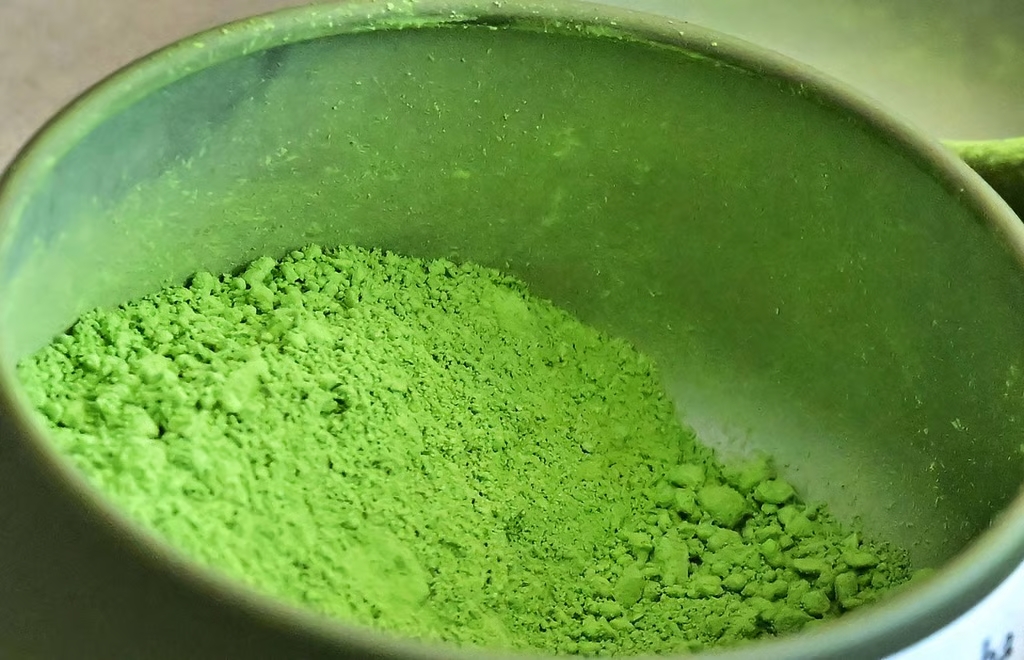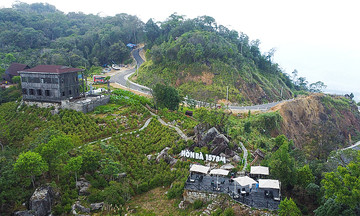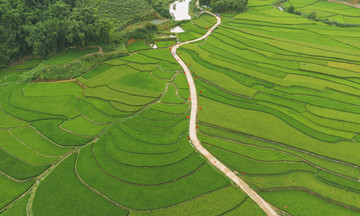At Kettl Tea, a minimalist matcha cafe in Los Angeles, the menu boasts 25 matcha varieties. However, due to global shortages, only 4 are currently available. Owner Zach Mangan says one of the hardest parts of the job is telling customers their favorite matcha is out of stock.
With its distinctive grassy aroma, vibrant green color, and energizing properties, matcha has become a global phenomenon. In 2024, matcha accounted for over 50% of Japan's total 8,798 tons of green tea exports, double the amount from 10 years prior, according to the Japanese Ministry of Agriculture.
 |
Matcha powder is made from tencha tea leaves. Photo: AFP |
Matcha powder is made from tencha tea leaves. Photo: AFP
"Matcha's popularity has grown exponentially over the past decade, but it has truly exploded in the last two to three years," Mangan says, adding that matcha has become a "cultural icon" in the West, appearing in everything from ice cream to cafe drinks. According to Mangan, the matcha market has nearly doubled in the past year alone. Her shop hasn't been able to restock since the beginning of the year.
While cafes scramble for supplies, Japanese tea farmers and matcha producers are struggling to meet the growing demand.
In Sayama, a city about 40 km northwest of Tokyo, Masahiro Okutomi, the 15th generation of a traditional tea-making family, is overwhelmed with orders. Okutomi has had to announce on his website that he is temporarily not accepting new matcha orders.
Matcha production is a labor-intensive process. It starts with tencha tea leaves, which are shaded before harvest. The leaves are then steamed, dried, deveined, and ground into a fine powder. These leaves are not for direct consumption but specifically for producing high-grade matcha.
"Producing quality matcha takes years of experience, investment in equipment and labor, and a long-term commitment," Okutomi says. He believes matcha's global popularity is a positive sign, but in the short term, it's a burden because supply can't keep up.
 |
Okutomi at his tea field in Sayama. Photo: AFP |
Okutomi at his tea field in Sayama. Photo: AFP
Social media has further fueled the matcha craze. Andie Ella, a 23-year-old French influencer with over 600,000 YouTube subscribers, has developed her own matcha brand. At her pastel-pink pop-up shop in Harajuku, Tokyo, long lines of fans queue to take photos and purchase boxes of strawberry or white chocolate-flavored matcha.
"Matcha is incredibly visually appealing," Ella says. Her matcha brand, sourced from Mie prefecture and launched in 11/2023, has sold 133,000 boxes and now employs a team of 8. Customer demand for matcha continues to steadily increase.
At Jugetsudo teahouse in Tokyo's Tsukiji Outer Market, the former fish market now a popular tourist destination, manager Shigehito Nishikida says the shop carefully manages its inventory. While they don't limit retail sales, they often refuse bulk orders if they suspect resale.
"In the last two to three years, the craze has intensified, with customers wanting to make their own matcha after learning from videos on social media," Nishikida says.
Anita Jordan, a 49-year-old Australian tourist, says her children are matcha enthusiasts and tasked her with finding the best quality matcha to bring home from her trip to Japan.
Experts worry that the global matcha market could face difficulties if the US raises import tariffs from 10% to 24% as planned by President Donald Trump. Reduced supply combined with higher tariffs would force shops to raise prices.
"It's not easy for us to increase prices, but customers are still buying, even worried about matcha running out," says the owner of Kettl Tea in Los Angeles. At the cafe, matcha is typically served as a latte or whisked with hot water in a ceramic bowl for a traditional experience. A plain matcha drink starts at 10 USD, while 20 grams of matcha powder for home brewing ranges from 25 to 150 USD.
The Japanese government is encouraging farmers to expand tea cultivation to lower costs. However, Okutomi believes this could compromise quality. Expansion is nearly impossible for small rural farms. Currently, the number of tea plantations in Japan has decreased to one-fourth of what it was 20 years ago, due to aging farmers and a lack of successors.
"Training the younger generation takes time; it can't be rushed," Okutomi says.
Mai Phuong (SCMP)












